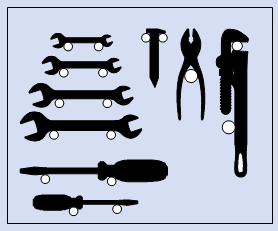 |
The five Ss: Number 2: Seiton (neatness)
The second S is Seiton, meaning ‘neatness’.
Where Seiri includes getting rid of the things that you do not need, Seiton
follows closely on by ensuring what you leave is tidy and available where
and when you need it.
Seiton means tidily putting things away after you have used them. Putting
things away requires following three rules: Decide where things belong;
Decide how things should be put away; Follow the put-away rules to leave
things where they can be quickly and properly found next time they are
needed.
To set up the put-away rules, do an analysis of how the things are used.
Pay particular attention to when and how they are are picked up and used.
This is a primary driver of how and where they are put away. If something
is used 50 times a day, then this multiplies the time wasted in finding
the item and taking it to where it is to be used.
Where confusion exists about the item, then it should be identified in
some way. For example, when selecting one of a set of spanners, if each
spanner is uniquely marked, for example with standardised numbers or colours,
then mistakes and consequent wasted time can be eliminated.
Labelling and naming should be similarly standardised. Decide whether
you will call a tool a nutspinner or a hex spanner. Write labels and other
signs clearly so it can be read at an appropriate distance. Ensure the
naming cannot get lost, for example by using paint rather than paper labels
that can fall off or wear away. If a label is to be changed, then use
an appropriate fixing system that holds the label firmly in place for
the duration, yet allows it to be easily removed and replaced. For example
if a sign is permanent, then screws are appropriate. If, however, it is
to be changed each week, then clips or a slotted holder would be better.
Make the item and the storage location match, for example by writing the
same name on the item and the storage. The tool board, as in Fig. 1, provides
a mechanism to store tools by painting their outline. This allows each
tool to be found instantaneously and also highlights when a tool is missing.
Storage locations for delicate items can be carved out of foam, such as
in a camera case. This also can be used to protect items which are to
be transported around the place.
Fig. 1.

Marks and signs on walls and floors can be used to indicate
walkways, storage areas, special usages and so on. Areas of floor and
complete areas can be painted different colours to indicate different
items, such as hazardous areas, rest areas, fork-lift pathways and so
on.
Wires get tangled and difficult to find in buried ducts, they get tripped
over or damaged when loose or stapled on floors. The best place can be
in overhead channeling.
Make sure storage is safe, both protecting the the item being stored and
preventing people from harming themselves when storing and retrieving.
Ensure there are no sharp corners and minimise stooping and lifting. Beware
of making storage cupboards unstable by putting heavy items at the top.
If necessary provide transport for heavy items, even storing them on a
trolley.
Even when you put things down on a workbench, think about the storage
aspects. A delicate gauge is better put on a rubber mat than a steel surface.
The put-away rules should also include instructions on cleaning. Stored
tools should be clean and free from any hazardous materials (as should
storage places). Damaged tools should not be put back: they should be
labelled and put in a designated area.
Balance the storage space with the things needing storing. Unused storage
is wastage. But neither cram things together so much you make it difficult
or hazardous to retrieve or where the items can damage one another.
Consider what will happen if you go to get something and it is not there.
If it is critical, then you will need access to backup items, whether
it is in another storecupboard or can be rapidly purchased from a supplier.
If two people use the same tool, use the analysis to determine whether
to purchase more items or have one person wait.
You can even get creative about storage, such as pressing a button to
have a light come on over the tool you need. Computerised storage can
go even further, bringing the items you want directly to your hand.
You may have noticed that Seiton is closely related to Seiri. Being organised
and being neat go together. This is characteristic of all five Ss: they
overlap significantly rather than cover very different subjects. Rather
than worry about what fits into Seiri and what fits into Seiton, use them
to reinforce each other and implement the whole thing.
Next:
Seiso (Cleaning)
Seiri
Seiton
Seiso
Seiketsu
Shitsuke

top of page |
 |
